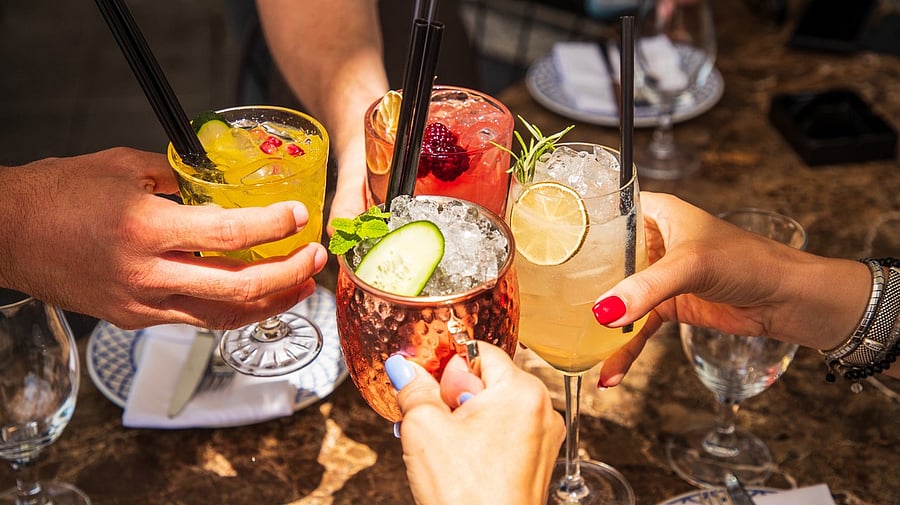
Representative image for cocktails.
Credit: iStock
Move over whisky and rum — the new toast of the town comes from India’s own backyard. Indigenous spirits like feni, mahua and toddy are steadily appearing on bar menus and cocktail charts, sparking conversations around craftsmanship, culture, and conscious drinking. Once sipped as part of local traditions and tabooed as “country liquor,” these native brews are now being reimagined by distillers, mixologists, and connoisseurs alike.
Said Goa? We heard feni!
Feni, a local spirit, tapped from cashew apples or coconut sap, has long been part of Goan culture and become synonymous with the state’s alco-bev scenes. At present, feni’s home state remains its largest market, with a couple of international markets on the horizon.
Feni cocktail
“Feni is not just a drink—it is one of the world’s most ancient distilled spirits, crafted in Goa for over 500 years. While it’s widely sipped in Goa in India, the drink has also witnessed great interest from Japan, where it is already being featured as a specialty spirit in high-end cocktails in some top bars in Tokyo. While overall sales still remain modest, volumes have doubled in the past five years,” says Hansel Vaz, secretary of the Cashew Feni Association.
Once limited to local taverns or hipster hideouts like Joseph Bar, feni is now being poured in a few bars on ‘Asia’s 50 Best’ list. Many now stock Cazulo, signaling a growing appreciation for its unique profile. Experiential spaces like Fazenda Cazulo have introduced immersive concepts such as Floating Feni, offering people an engaging way to taste and fall in love with this desi drink. Also, feni now carries the legitimacy of being the first Indian spirit to receive a Geographical Indication (GI).
Hansel Vaz
Mahua: India’s floral elixir
Mahua or mahura, which is grown in as many as 13 states in India, produces a much-enjoyed alcoholic beverage in areas where it is collected, distilled and served. Notably, mahua is the only spirit in the world that is distilled from a naturally sweet flower.
“While mahua has gotten a fair amount of attention over the past few years, it is not likely in the near future to dethrone our default national spirit. Prevailing excise policies are a major issue,” notes Conrad Braganza, the COO of the DesmondJi Craft Spirits, the label that launched mahua spirit and mahua liqueur in 2018. He tells us that the brand made a little over 10,000 bottles (equated to 750 ml) of mahua in their launch year and the quantities over the past few years have been fairly steady. “For India, mahua has the potential to be what tequila is to Mexico or what soju is to Korea,” he adds.
Mahua flowers
“The largest footprint of any spirit in this country is mahua, with 90 per cent of the total usage being in alcohol preparation,” says Aniruddha Mookerjee, an alcohol connoisseur with over 20 years of grassroot-level research on indigenous spirits and an advisor for Heritage Liquor to the Government of Madhya Pradesh.
Conrad Braganza
Toddy struggle
“Toddy has been banned for 37 years now in Tamil Nadu, mainly because of the dominance of TASMAC outlets,” says Ashok Kumar from the Salem Zone Palm Tree Climbing Workers Association.
He claims that TASMAC drinks don’t have nutritional value while toddy does, making it a probable alternative sip.
“Toddy (especially palmyra) has probiotic properties—it’s actually beneficial for health,” he says.
“We see toddy not as liquor, but as food. Even though it contains alcohol, which is less than six per cent, it is best described as a naturally fermented, nutrient-rich, low-alcohol drink that should be promoted as a health beverage,” he adds.
Seeking revocation of the ban on toddy in Tamil Nadu, he points out that Kerala is doing better than his state and leading in toddy production. The drink also has international demand, with Sri Lanka exporting its toddy to Europe and Australia, but he believes India will in the future be able to capture the market with government support and much-needed change in age-old policies.
Future of indigenous spirits
Aniruddha Mookerjee points out that the race for India’s indigenous spirits to occupy the centre-stage is long and only possible with key changes in policies regulating liquor production and supply. “The challenge to bringing recognition to mahua, feni and other India’s spirits lies in the excise laws. We also need to remove the colonial stigma associated with these spirits and do better with distribution,” he says.
Aniruddha Mookerjee
PHOTO CREDIT MICKY KALITA.jpg
Today, most of what is produced by the local mahua-making communities, and quietly sold in the market, is illegal, inconsistent and without any quality checks. Aniruddha adds, “Sometimes it is filled in tyre tubes and transported, which makes it toxic. We have to distinguish between personal home production, which is a customary right guaranteed by the Constitution in many parts of the country, and commercial production, which needs to be licensed, and adhere to FSSAI and BIS norms to be formally sold in the market. Until existing state policies uniformly change across India, distribution of indigenous spirits like mahua will be expensive, and difficult, through regular channels. But hopefully it will happen, perhaps in another decade,” he says.
Is India ready to get over whisky, and go desi?
Jonas Ax, renowned mixologist and Head of Advocacy, Bacardi (India & Neighboring Countries), notes that India has always been a whisky market, and that remains true even today. “Drinks like feni, mahua, and local rice-based brews are gaining popularity, especially in urban bars. This isn’t a replacement, but an expansion. Indian consumers are building a more layered drinking culture where Scotch continues to sit alongside homegrown traditions,” Jonas explains.
Jonas Ax, Head of Advocacy, Bacardi - India & Neighboring Countries
Nibaran Mandal, Senior F&B Supervisor and Bartender, Deltin Suites, Goa, agrees with Jonas and reflects on the visible curiosity around indigenous spirits. “While some purists enjoy sipping feni or mahua neat to truly appreciate their earthy notes and layered aromas, a growing number of patrons are discovering them through cocktails. The 25–40 age group is leading this exploration. For them, cocktails crafted with feni or mahua aren’t just drinks but also cultural experiences—stories in a glass that connect tradition with modernity. This evolving interest marks a positive shift,” the bartender shares.
Nibaran Mandal
“India will remain a whisky-first market for the foreseeable future, dominated by the ‘big four’ international companies—Diageo, Pernod Ricard, Bacardi, and William Grant & Sons,” Hansel says.
“Mahua, toddy and feni are all in the race together for recognition and the makers and sellers of these indigenous spirits should adopt a collaborative approach so as to learn from each other,” Conrad concludes.
(This article is for informational purposes only and is not intended to promote or condone the abuse of alcohol. Alcohol should be consumed responsibly and in moderation by individuals of legal drinking age.)
